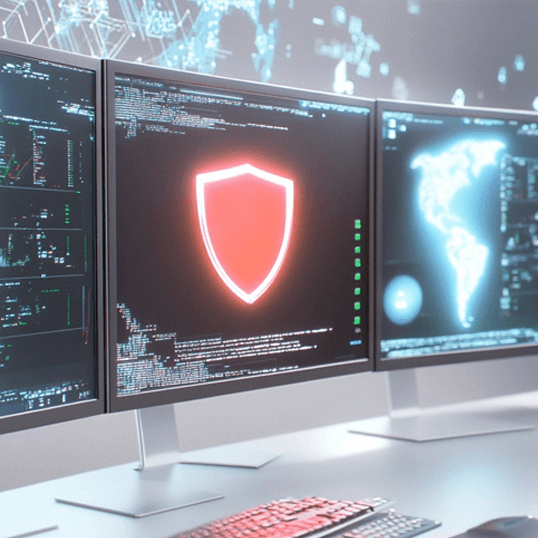Traditional security measures often fall short in providing comprehensive protection. This is where Managed Extended Detection and Response (MxDR) comes into play. But what is MxDR, and why is it becoming a critical component of modern cybersecurity strategies?
MxDR is an advanced security solution that combines multiple security functions into a unified platform. It integrates threat detection, investigation, and response capabilities with ongoing monitoring and management. By leveraging the latest technologies and expert analysis, MxDR offers a proactive approach to identifying and mitigating threats before they can cause significant harm.
The Need for MxDR
Today’s threat landscape demands a shift from reactive to proactive security measures. Organizations must be prepared to detect threats in real-time and respond swiftly to minimize potential damage. MxDR provides this capability by offering continuous monitoring and rapid incident response, all managed by experienced security professionals.
The adoption of MxDR is not just a trend but a necessity for organizations aiming to enhance their security posture. With the increasing complexity of IT environments and the rise of advanced persistent threats (APTs), having a robust, managed security solution is essential.
Overview of MxDR
- Comprehensive Coverage: MxDR encompasses a wide range of security functions, including threat intelligence, behavior analysis, endpoint detection and response (EDR), and security information and event management (SIEM).
- Scalability: MxDR solutions are designed to scale with an organization’s needs, ensuring that as the business grows, its security infrastructure can adapt accordingly.
- Expert Management: By utilizing a managed service provider, organizations can access a team of security experts who can provide insights, guidance, and support in navigating the complex cybersecurity landscape.
By understanding what MxDR is and how it functions, organizations can make informed decisions about integrating this powerful tool into their cybersecurity strategy. As the article unfolds, we will explore the components, benefits, challenges, and future trends of MxDR, providing a comprehensive guide to this essential security solution.
Understanding The Basics
As the cybersecurity landscape becomes more complex, understanding the nuances of advanced security solutions like Managed Extended Detection and Response (MxDR) is crucial for organizations seeking to enhance their defense mechanisms. This section will delve into the fundamental aspects of MxDR, providing a solid foundation for grasping its role in modern cybersecurity.
Definition of MxDR
What is MxDR? Managed Extended Detection and Response (MxDR) is an advanced cybersecurity solution that integrates multiple security services into a cohesive, managed platform. Unlike traditional security solutions that often operate in silos, MxDR unifies threat detection, analysis, and response capabilities to provide a comprehensive security framework.
MxDR leverages cutting-edge technologies such as artificial intelligence, machine learning, and automation to identify and mitigate threats across an organization’s entire digital ecosystem. By doing so, it offers a proactive approach to cybersecurity, enabling organizations to detect potential threats before they can escalate into full-blown attacks.
Key Components of MxDR
MxDR is composed of several critical components that work together to provide robust security coverage:
- Threat Intelligence: MxDR solutions incorporate threat intelligence feeds to stay updated on the latest cyber threats and vulnerabilities. This information allows organizations to anticipate potential attacks and adapt their defenses accordingly.
- Endpoint Detection and Response (EDR): EDR tools monitor endpoints such as laptops, desktops, and servers for suspicious activities. By analyzing behavior patterns, EDR identifies anomalies that may indicate a cyber threat, enabling rapid response.
- Security Information and Event Management (SIEM): SIEM systems aggregate and analyze security data from various sources across the organization. By correlating events and identifying patterns, SIEM provides actionable insights that inform security decisions.
- Network Traffic Analysis (NTA): NTA tools examine network traffic to detect unusual patterns and behaviors that could signify a cyber threat. By monitoring data flows in real-time, NTA helps identify potential intrusions and anomalies.
- Automated Response and Orchestration: MxDR solutions often include automation features that streamline incident response processes. Automation reduces the time between threat detection and response, minimizing the impact of attacks.
- Continuous Monitoring and Management: One of the hallmarks of MxDR is its ability to provide 24/7 monitoring and management of an organization’s security infrastructure. This constant vigilance ensures that threats are identified and addressed promptly.
The Role of MxDR in Security Strategy
MxDR plays a pivotal role in enhancing an organization’s security posture by providing a unified platform that addresses the multifaceted nature of cyber threats. Its ability to integrate various security functions and provide real-time insights makes it an indispensable tool for businesses aiming to protect their digital assets effectively.
By understanding the key components and functions of MxDR, organizations can better appreciate its value and how it fits into their broader cybersecurity strategy. In the next section, we will explore how MxDR works in practice, shedding light on the processes and technologies that underpin this powerful security solution.
How MxDR Works
Understanding how Managed Extended Detection and Response (MxDR) functions are essential for grasping its value in a cybersecurity strategy. This section will explore the operational aspects of MxDR, detailing the processes and technologies that enable it to provide comprehensive threat detection and response capabilities.
Detection
At the core of MxDR is its ability to detect potential threats across an organization’s digital environment. This is achieved through a combination of advanced technologies and methodologies that work in concert to identify suspicious activities and anomalies.
- Behavioral Analysis: MxDR employs behavioral analysis to monitor user and entity behavior. By establishing a baseline of normal activity, MxDR can identify deviations that may indicate malicious intent. This approach is particularly effective in detecting insider threats and zero-day attacks, which often evade traditional signature-based detection methods.
- Machine Learning and AI: Machine learning algorithms are integral to MxDR’s detection capabilities. These algorithms analyze vast amounts of data to identify patterns and anomalies that could signify a threat. Over time, they adapt and improve, enhancing the system’s ability to recognize subtle indicators of compromise.
- Threat Intelligence Integration: MxDR solutions integrate threat intelligence feeds from various sources, providing real-time updates on emerging threats and vulnerabilities. This intelligence informs detection efforts, enabling organizations to stay ahead of the evolving threat landscape.
Response
Once a potential threat is detected, MxDR solutions are equipped to respond swiftly and effectively, minimizing the impact of security incidents. The response process involves several key steps:
- Incident Triage and Prioritization: MxDR platforms automatically categorize and prioritize incidents based on their severity and potential impact. This ensures that the most critical threats receive immediate attention, allowing security teams to allocate resources efficiently.
- Automated Response: Many MxDR solutions incorporate automation to expedite the response process. Automated workflows can execute predefined actions, such as isolating compromised systems, blocking malicious IP addresses, and deploying patches. Automation reduces response times and mitigates threats before they can escalate.
- Human Expertise: While automation plays a significant role in MxDR, human expertise remains crucial. Security analysts and incident responders work alongside automated systems to investigate complex threats, refine detection rules, and make strategic decisions. Their insights and experience enhance the overall effectiveness of the MxDR solution.
Integration with Existing Systems
A critical advantage of MxDR is its ability to integrate seamlessly with an organization’s existing security infrastructure. This integration ensures that MxDR solutions complement and enhance current security measures rather than replace them.
- SIEM and EDR Integration: MxDR solutions often integrate with existing SIEM and EDR platforms, leveraging their data and capabilities to provide a unified view of the organization’s security posture. This integration enables more accurate threat detection and response, as information is consolidated and analyzed holistically.
- Cloud and On-Premises Environments: MxDR is designed to operate effectively in both cloud and on-premises environments. It provides visibility and protection across diverse IT infrastructures, ensuring that organizations can secure their assets regardless of where they are located.
- Customizable Workflows: MxDR solutions offer customizable workflows that align with an organization’s specific security policies and procedures. This flexibility ensures that the solution meets the unique needs of each organization, providing tailored protection that adapts to evolving threats.
By understanding how MxDR works, organizations can appreciate the depth and breadth of protection it offers. In the next section, we will delve into the key features and benefits of MxDR, highlighting why it is becoming an essential component of modern cybersecurity strategies.
Key Features and Benefits of MxDR
Managed Extended Detection and Response (MxDR) is increasingly recognized as a vital component of modern cybersecurity strategies. By leveraging advanced technologies and expert management, MxDR offers a comprehensive security solution that addresses the dynamic nature of today’s threat landscape. This section explores the key features and benefits of MxDR, illustrating its value for organizations seeking to enhance their security posture.
Proactive Threat Detection
One of the standout features of MxDR is its ability to provide proactive threat detection. Unlike traditional security solutions that rely heavily on reactive measures, MxDR focuses on identifying potential threats before they can cause harm.
- Real-Time Monitoring: MxDR solutions continuously monitor an organization’s network, endpoints, and cloud environments for signs of malicious activity. This real-time visibility enables early detection of threats, allowing organizations to act swiftly and decisively.
- Anomaly Detection: By analyzing behavior patterns across the network, MxDR can identify anomalies that may indicate a breach. This includes unusual user behavior, unexpected data transfers, and other deviations from normal activity that could signal a threat.
- Predictive Analytics: Leveraging predictive analytics, MxDR anticipates potential threats based on historical data and emerging trends. This foresight allows organizations to strengthen their defenses proactively, addressing vulnerabilities before they are exploited.
Automated Incident Response
Another critical advantage of MxDR is its ability to automate incident response processes. Automation reduces the time and effort required to respond to threats, minimizing potential damage and disruption.
- Rapid Mitigation: Automated workflows enable MxDR solutions to execute predefined actions in response to detected threats. This includes isolating affected systems, blocking malicious traffic, and applying security patches, all without human intervention.
- Scalable Solutions: Automation allows MxDR solutions to scale with an organization’s needs, handling increased threat volumes without overwhelming security teams. This scalability ensures that organizations can maintain robust defenses even as they grow.
- Consistent Execution: Automated response procedures ensure consistent and timely execution of security protocols, reducing the risk of human error. This consistency enhances the overall effectiveness of the organization’s incident response strategy.
24/7 Monitoring and Support
In today’s always-on digital environment, round-the-clock monitoring and support are crucial for maintaining a strong security posture. MxDR provides continuous oversight, ensuring that threats are identified and addressed promptly.
- Global Threat Intelligence: MxDR providers maintain a global network of threat intelligence sources, offering insights into emerging threats and vulnerabilities. This intelligence informs detection and response efforts, keeping organizations ahead of adversaries.
- Dedicated Security Operations Center (SOC): Many MxDR solutions include access to a dedicated SOC staffed by experienced security professionals. These experts provide ongoing monitoring, threat analysis, and incident response support, enhancing the organization’s security capabilities.
- Comprehensive Reporting: MxDR solutions often include detailed reporting and analytics features, providing organizations with insights into their security posture and incident history. This information aids in decision-making and strategy development, ensuring continuous improvement.
Scalability and Flexibility
The scalability and flexibility of MxDR solutions make them suitable for organizations of all sizes and industries. By adapting to changing needs and environments, MxDR ensures that organizations remain protected as they evolve.
- Adaptable Solutions: MxDR solutions can be tailored to meet the specific needs of each organization, offering customizable workflows, policies, and procedures. This adaptability ensures that the solution aligns with the organization’s security goals and requirements.
- Support for Hybrid Environments: As organizations increasingly adopt hybrid cloud architectures, MxDR provides protection across both on-premises and cloud environments. This comprehensive coverage ensures that all assets are secured, regardless of their location.
- Cost-Effective Protection: By outsourcing security functions to an MxDR provider, organizations can reduce the burden on internal IT teams and avoid the costs associated with maintaining a full-fledged security operation in-house. This cost-effectiveness makes MxDR an attractive option for organizations looking to optimize their security spending.
By leveraging these key features, MxDR solutions offer a robust and comprehensive approach to cybersecurity, addressing the challenges and complexities of the modern threat landscape. In the next section, we will examine the importance of MxDR in cybersecurity, highlighting how it compares to traditional security solutions and its role in enhancing an organization’s security posture.
The Importance of MxDR in Cybersecurity
In the face of a rapidly evolving threat landscape, traditional security measures often fall short of providing adequate protection against sophisticated cyberattacks. Managed Extended Detection and Response (MxDR) has emerged as a critical solution to bridge these gaps and enhance an organization’s overall security posture. This section explores the importance of MxDR in cybersecurity, comparing it to traditional solutions and highlighting its role in strengthening an organization’s defenses.
Comparing MxDR with Traditional Security Solutions
Traditional security solutions, such as firewalls, antivirus software, and intrusion detection systems, have been the cornerstone of cybersecurity for many years. However, they have limitations that make them less effective in addressing today’s complex threats.
- Reactive vs. Proactive: Traditional security measures are often reactive, relying on signatures and known patterns to identify threats. While this approach can be effective against known malware and attacks, it struggles with zero-day threats and sophisticated adversaries. In contrast, MxDR provides proactive threat detection, leveraging behavioral analysis, machine learning, and threat intelligence to identify potential threats before they can cause harm.
- Siloed Operations: Traditional security solutions typically operate in silos, each focusing on specific aspects of security. This fragmented approach can lead to blind spots and inefficient incident response. MxDR, on the other hand, integrates various security functions into a unified platform, providing a holistic view of the organization’s security posture and enabling more coordinated responses.
- Limited Visibility: Many traditional solutions lack the visibility required to detect threats across an organization’s entire digital ecosystem. MxDR provides comprehensive coverage, monitoring networks, endpoints, and cloud environments for signs of malicious activity. This broad visibility is essential for identifying advanced persistent threats (APTs) and other sophisticated attacks.
Enhancing Security Posture with MxDR
The adoption of MxDR offers several advantages that significantly enhance an organization’s security posture:
- Increased Threat Detection and Response Capabilities: MxDR solutions are designed to detect and respond to threats across the entire attack surface. By providing continuous monitoring and real-time insights, MxDR enables organizations to identify and mitigate threats more effectively than traditional solutions.
- Improved Incident Response Times: With automated workflows and expert management, MxDR solutions reduce the time it takes to respond to security incidents. This rapid response minimizes the impact of attacks, reducing downtime and potential damage.
- Enhanced Threat Intelligence: MxDR providers maintain extensive threat intelligence networks, offering organizations access to up-to-date information on emerging threats and vulnerabilities. This intelligence informs detection and response efforts, ensuring that organizations remain one step ahead of adversaries.
- Comprehensive Risk Management: MxDR solutions provide organizations with the tools and insights needed to manage cybersecurity risks effectively. By identifying vulnerabilities and potential threats, MxDR enables organizations to prioritize remediation efforts and allocate resources more strategically.
- Continuous Improvement: The dynamic nature of MxDR allows organizations to adapt to evolving threats and continuously improve their security posture. With regular updates, threat intelligence, and expert guidance, MxDR solutions ensure that organizations are prepared to face the challenges of the modern threat landscape.
The Role of MxDR in Modern Cybersecurity Strategies
As cyber threats continue to evolve, organizations must adopt advanced security solutions that provide comprehensive protection against a wide range of attacks. MxDR plays a crucial role in modern cybersecurity strategies by offering a proactive, integrated, and flexible approach to threat detection and response.
- Aligning with Regulatory Requirements: Many industries face stringent regulatory requirements related to cybersecurity and data protection. MxDR solutions help organizations comply with these regulations by providing robust security measures and detailed reporting capabilities.
- Supporting Digital Transformation: As organizations undergo digital transformation, they often adopt new technologies and architectures that introduce additional security challenges. MxDR solutions provide the adaptability and scalability needed to secure these evolving environments, supporting innovation while maintaining strong defenses.
- Enabling Strategic Decision-Making: By providing comprehensive insights into an organization’s security posture, MxDR enables decision-makers to make informed choices about risk management, resource allocation, and strategic investments. This strategic perspective is essential for aligning cybersecurity efforts with broader business goals.
In conclusion, the importance of MxDR in cybersecurity cannot be overstated. By providing a unified platform for threat detection and response, MxDR enhances an organization’s ability to defend against sophisticated attacks and strengthens its overall security posture. In the next section, we will explore the challenges and considerations associated with implementing MxDR, offering guidance for organizations looking to integrate this powerful solution into their cybersecurity strategy.
Challenges and Considerations in Implementing MxDR
While Managed Extended Detection and Response (MxDR) offers a comprehensive and proactive approach to cybersecurity, implementing it within an organization can present certain challenges. Understanding these challenges and considerations is crucial for ensuring a successful deployment and maximizing the benefits of MxDR. This section explores the key obstacles organizations may face when integrating MxDR solutions and offers insights into addressing these challenges effectively.
Integration with Legacy Systems
One of the primary challenges organizations face when implementing MxDR is integrating it with existing legacy systems. Many organizations have invested heavily in traditional security solutions and IT infrastructure, which may not be immediately compatible with modern MxDR platforms.
- Compatibility Issues: Legacy systems often lack the flexibility and interoperability required to seamlessly integrate with MxDR solutions. This can result in compatibility issues that hinder the effectiveness of threat detection and response efforts.
- Data Silos: Legacy systems may operate in silos, preventing the free flow of information needed for comprehensive threat analysis. This fragmentation can limit the visibility and coordination capabilities of MxDR solutions.
Strategies to Overcome Integration Challenges:
- Conduct a Thorough Assessment: Before implementing MxDR, organizations should conduct a thorough assessment of their existing IT infrastructure and security solutions. This assessment will help identify potential integration challenges and inform the development of a tailored implementation plan.
- Leverage APIs and Connectors: Many MxDR solutions offer APIs and connectors that facilitate integration with legacy systems. Organizations can leverage these tools to bridge compatibility gaps and ensure seamless data exchange between systems.
- Incremental Deployment: Instead of attempting a full-scale integration from the outset, organizations can consider an incremental deployment approach. This involves gradually integrating MxDR capabilities, starting with high-priority areas and expanding coverage over time.
Cost and Resource Allocation
Implementing MxDR requires careful consideration of cost and resource allocation. While MxDR solutions can be cost-effective in the long run, initial deployment and ongoing management costs may pose challenges for organizations with limited budgets.
- Upfront Costs: The initial costs associated with purchasing and deploying an MxDR solution can be significant, particularly for small and medium-sized enterprises (SMEs).
- Ongoing Management: MxDR solutions require ongoing management and support, which can strain internal resources and budgets. Organizations must allocate sufficient resources to ensure effective monitoring and maintenance.
Strategies to Manage Costs and Resources:
- Evaluate Total Cost of Ownership (TCO): When considering an MxDR solution, organizations should evaluate the total cost of ownership, including initial deployment, ongoing management, and potential savings from improved threat detection and response.
- Prioritize Critical Assets: To manage costs effectively, organizations can prioritize the protection of critical assets and high-risk areas. This targeted approach ensures that resources are allocated where they are needed most.
- Consider Managed Service Providers: Partnering with a managed service provider (MSP) can help organizations access expert management and support without the need for extensive in-house resources. MSPs can offer scalable solutions that align with an organization’s budget and security needs.
Change Management and User Adoption
The successful implementation of MxDR requires effective change management and user adoption strategies. Organizations must ensure that their teams are prepared to embrace new technologies and processes.
- Resistance to Change: Employees may resist adopting new security solutions and processes, particularly if they are accustomed to existing systems and workflows.
- Training and Education: Lack of training and education can hinder user adoption, as employees may struggle to understand and utilize the new MxDR capabilities effectively.
Strategies to Facilitate Change Management:
- Engage Stakeholders Early: Engaging key stakeholders early in the implementation process helps build support and buy-in for the MxDR solution. Involving stakeholders in decision-making and planning fosters a sense of ownership and commitment.
- Provide Comprehensive Training: Organizations should invest in comprehensive training programs that equip employees with the knowledge and skills needed to leverage MxDR effectively. Training should cover technical aspects, threat awareness, and best practices.
- Communicate Benefits: Clearly communicating the benefits of MxDR to employees and stakeholders can help overcome resistance to change. Highlighting improved threat detection, faster response times, and enhanced security can motivate teams to embrace the new solution.
Ensuring Compliance and Data Privacy
Implementing MxDR also requires organizations to consider compliance and data privacy requirements. As cyber threats evolve, regulatory requirements related to data protection and privacy are becoming increasingly stringent.
- Data Protection Regulations: Organizations must ensure that their MxDR solutions comply with relevant data protection regulations, such as GDPR, HIPAA, and CCPA. Non-compliance can result in significant legal and financial penalties.
- Data Sovereignty: For multinational organizations, data sovereignty considerations may arise, particularly when data is processed or stored in different jurisdictions with varying regulations.
Strategies to Ensure Compliance and Privacy:
- Conduct a Compliance Audit: Before implementing MxDR, organizations should conduct a compliance audit to identify regulatory requirements and potential risks. This audit will inform the development of a compliance strategy that aligns with legal obligations.
- Implement Data Privacy Controls: MxDR solutions should include robust data privacy controls that protect sensitive information and ensure compliance with relevant regulations. Encryption, access controls, and data anonymization are essential components of a privacy-centric approach.
- Collaborate with Legal Experts: Organizations should collaborate with legal experts to navigate complex regulatory landscapes and ensure that their MxDR implementation aligns with legal requirements. Legal guidance can help mitigate compliance risks and protect the organization from potential liabilities.
In summary, while implementing MxDR can present challenges, organizations can overcome these obstacles with careful planning, strategic resource allocation, and effective change management. By addressing these considerations, organizations can successfully integrate MxDR solutions and harness their full potential to enhance cybersecurity. In the next section, we will explore how organizations can choose the right MxDR provider, offering insights into the selection process and key criteria to consider.
Choosing the Right MxDR Provider
Selecting the right Managed Extended Detection and Response (MxDR) provider is crucial for ensuring that your organization can fully leverage the benefits of this advanced security solution. With many providers offering a range of services and capabilities, making the right choice requires careful evaluation of your organization’s specific needs and the provider’s offerings. This section explores the key criteria for selecting an MxDR provider and offers insights into the evaluation process.
Criteria for Selection
When choosing an MxDR provider, it’s important to consider several key criteria that will impact the effectiveness of the solution and its alignment with your organization’s security strategy.
- Expertise and Experience: The provider’s expertise and experience in the cybersecurity field are critical factors to consider. Look for providers with a proven track record in delivering MxDR services, and ensure they have experience working with organizations of similar size and industry.
- Technology Stack: Evaluate the provider’s technology stack to ensure it aligns with your organization’s needs. The provider should offer a comprehensive suite of tools and technologies, including threat intelligence, endpoint detection and response (EDR), security information and event management (SIEM), and automation capabilities. SIEM platform providers like MxDR for Microsoft and MxDR for Google are leading the space.
- Customization and Flexibility: The provider should offer customizable solutions that can be tailored to meet your organization’s unique security requirements. Flexibility in service delivery, integration with existing systems, and the ability to adapt to changing needs are essential considerations.
- Global Threat Intelligence: A strong MxDR provider should have access to a wide range of global threat intelligence sources. This access enables them to stay ahead of emerging threats and provide timely, actionable insights that enhance threat detection and response efforts.
- Compliance and Data Privacy: Ensure that the provider adheres to relevant compliance and data privacy regulations. They should have robust policies and controls in place to protect sensitive data and ensure compliance with regulations such as GDPR, HIPAA, and CCPA.
- Customer Support and Service Level Agreements (SLAs): Evaluate the provider’s customer support capabilities, including the availability of 24/7 support and the responsiveness of their team. Service Level Agreements (SLAs) should clearly define the provider’s commitments to service quality, response times, and incident resolution.
Evaluating Provider Capabilities
Once you have identified potential MxDR providers, evaluating their capabilities in-depth is crucial to making an informed decision. Here are some steps to guide your evaluation process:
- Request a Proof of Concept (PoC): Before committing to a provider, request a PoC to evaluate their solution’s performance in your environment. This trial period allows you to assess the provider’s capabilities, ease of integration, and effectiveness in detecting and responding to threats.
- Review Case Studies and References: Review case studies and request references from organizations similar to yours. This will provide insights into the provider’s ability to deliver on their promises and their track record of success in similar environments.
- Assess Integration Capabilities: Evaluate the provider’s ability to integrate with your existing security infrastructure and IT systems. Seamless integration is crucial for maximizing the effectiveness of the MxDR solution and ensuring a unified security approach.
- Analyze Reporting and Analytics Features: Review the provider’s reporting and analytics features to ensure they offer the insights and visibility needed to make informed security decisions. Comprehensive reporting capabilities are essential for understanding your security posture and tracking the effectiveness of threat detection and response efforts.
- Evaluate Scalability: Assess the provider’s ability to scale their services as your organization grows. The MxDR solution should accommodate increased threat volumes, new technologies, and evolving security requirements without compromising performance.
- Consider Cultural Fit and Collaboration: Consider the provider’s cultural fit with your organization and their willingness to collaborate and build a strong partnership. A successful MxDR implementation requires open communication, trust, and alignment of goals between the provider and your organization.
Making the Final Decision
Once you have thoroughly evaluated potential MxDR providers, consider the following factors to make the final decision:
- Cost vs. Value: Evaluate the cost of the MxDR solution in relation to the value it provides. While cost is important, the provider’s ability to enhance your organization’s security posture and deliver tangible benefits should be the primary consideration.
- Long-Term Partnership Potential: Choose a provider with whom you can establish a long-term partnership. This ensures ongoing support, continuous improvement, and alignment with your organization’s evolving security needs.
- Alignment with Business Goals: Ensure that the chosen MxDR provider aligns with your organization’s broader business goals and objectives. The provider should support your organization’s mission and contribute to achieving strategic initiatives.
By carefully selecting the right MxDR provider, organizations can ensure a successful implementation that enhances their cybersecurity defenses and supports their long-term security strategy. In the next section, we will explore future trends in MxDR, providing insights into how this technology is expected to evolve and shape the cybersecurity landscape in the coming years.
Future Trends
The field of Managed Extended Detection and Response (MxDR) is continuously evolving to meet the challenges of an increasingly complex cybersecurity landscape. As threats become more sophisticated, MxDR solutions must adapt to provide enhanced protection and proactive defense strategies. This section explores the future trends in MxDR, offering insights into how this technology is expected to evolve and shape the cybersecurity landscape in the coming years.
Advancements in AI and Automation
Artificial intelligence (AI) and automation are at the forefront of innovation in cybersecurity, and their role in MxDR solutions is expected to expand significantly. These technologies offer numerous benefits that enhance threat detection, analysis, and response capabilities.
- Enhanced Threat Detection: AI-powered algorithms can process vast amounts of data in real-time, identifying patterns and anomalies that may indicate a cyber threat. As AI continues to advance, MxDR solutions will become even more adept at detecting complex threats, including zero-day vulnerabilities and advanced persistent threats (APTs).
- Improved Accuracy and Speed: Automation enables MxDR solutions to respond to threats with unprecedented speed and accuracy. Automated workflows can execute predefined response actions, such as isolating affected systems and deploying patches, minimizing the impact of attacks and reducing the burden on security teams.
- Adaptive Learning and Continuous Improvement: Future MxDR solutions will leverage machine learning models that continuously learn from new data and adapt to evolving threat landscapes. This adaptive learning capability will enable MxDR to stay ahead of emerging threats, providing organizations with a dynamic and resilient security posture.
- Natural Language Processing (NLP): As AI technology matures, the integration of NLP will improve the ability of MxDR systems to understand and interpret human language. This advancement will enhance threat intelligence gathering and analysis, allowing MxDR solutions to better understand threat actor communications and intentions.
Evolving Threat Landscape
The threat landscape is constantly changing, with cybercriminals adopting new tactics and techniques to exploit vulnerabilities. MxDR solutions must evolve to address these emerging threats and provide comprehensive protection.
- Increased Use of Ransomware: Ransomware attacks are expected to become more prevalent and sophisticated, targeting organizations across various industries. Future MxDR solutions will need to enhance their capabilities to detect and prevent ransomware attacks, focusing on early detection and rapid response to minimize damage.
- IoT and OT Security Challenges: The proliferation of Internet of Things (IoT) devices and operational technology (OT) systems introduces new security challenges. MxDR solutions will need to adapt to protect these environments, providing visibility and control over a diverse range of connected devices.
- Supply Chain Attacks: Cybercriminals are increasingly targeting supply chains to gain access to critical systems and data. Future MxDR solutions will need to focus on securing the supply chain, identifying vulnerabilities, and preventing unauthorized access to sensitive information.
- Increased Focus on Data Privacy: With the introduction of new data privacy regulations and the growing emphasis on protecting sensitive information, MxDR solutions will need to enhance their data privacy controls. This includes implementing advanced encryption, access controls, and data anonymization techniques to ensure compliance and protect against data breaches.
Integration with Emerging Technologies
The integration of MxDR with emerging technologies will play a significant role in shaping its future capabilities. These integrations will enhance the effectiveness and reach of MxDR solutions, providing organizations with more comprehensive security coverage.
- Integration with Cloud Security: As organizations continue to migrate to the cloud, MxDR solutions will need to integrate with cloud security platforms to provide seamless protection across hybrid environments. This integration will enable MxDR to monitor and secure cloud-native applications, data, and infrastructure.
- Collaboration with Security Orchestration, Automation, and Response (SOAR): The integration of MxDR with SOAR platforms will enhance automation and incident response capabilities, enabling organizations to streamline security operations and improve efficiency.
- Support for Blockchain Technology: As blockchain technology gains traction across various industries, MxDR solutions will need to incorporate features that address blockchain-specific security challenges. This includes monitoring blockchain networks for suspicious activities and preventing unauthorized access to distributed ledger systems.
- Adoption of Zero Trust Architecture: The zero trust security model, which assumes that threats may originate from both inside and outside the network, is becoming increasingly popular. Future MxDR solutions will need to support zero trust principles, providing continuous verification of user identities and access permissions to prevent unauthorized access.
Increased Demand for Managed Security Services
The demand for managed security services, including MxDR, is expected to grow as organizations recognize the value of outsourcing security functions to expert providers. This trend is driven by several factors:
- Skill Shortages and Resource Constraints: Many organizations face skill shortages and resource constraints that limit their ability to manage complex security operations in-house. MxDR providers offer access to experienced security professionals who can provide expert guidance and support.
- Focus on Core Business Functions: By outsourcing security operations to an MxDR provider, organizations can focus on their core business functions and strategic initiatives. This allows them to allocate resources more effectively and achieve their business objectives.
- Cost-Effectiveness: Managed security services offer a cost-effective solution for organizations looking to enhance their security posture without the need for significant investments in technology and personnel. MxDR providers offer scalable solutions that align with an organization’s budget and security needs.
In conclusion, the future of MxDR is shaped by advancements in AI and automation, the evolving threat landscape, integration with emerging technologies, and the growing demand for managed security services. By staying abreast of these trends, organizations can leverage MxDR solutions to enhance their cybersecurity defenses and protect against the threats of tomorrow. In the final section, we will summarize the strategic advantages of MxDR and address frequently asked questions about this essential security solution.
Conclusion
Key Benefits of MxDR
The strategic advantages of implementing MxDR are manifold, providing organizations with the tools and capabilities needed to secure their digital environments effectively.
- Comprehensive Threat Detection and Response: MxDR solutions offer a holistic approach to cybersecurity by integrating multiple security functions into a unified platform. This comprehensive coverage enables organizations to detect and respond to threats across their entire digital ecosystem, ensuring robust protection against a wide range of attacks.
- Proactive Security Posture: By leveraging AI, machine learning, and behavioral analysis, MxDR solutions provide proactive threat detection capabilities. This approach allows organizations to identify potential threats before they can escalate, reducing the risk of breaches and minimizing the impact of attacks.
- Scalability and Flexibility: MxDR solutions are designed to scale with an organization’s needs, adapting to changing security requirements and evolving threat landscapes. This flexibility ensures that organizations can maintain strong defenses as they grow and expand their operations.
- Enhanced Threat Intelligence: Access to global threat intelligence enables MxDR solutions to stay ahead of emerging threats and vulnerabilities. By providing timely and actionable insights, MxDR enhances an organization’s ability to anticipate and mitigate potential risks.
- Cost-Effective Security Management: Outsourcing security functions to an MxDR provider offers a cost-effective solution for organizations seeking to optimize their cybersecurity spending. By leveraging managed services, organizations can reduce the burden on internal resources and benefit from expert management and support.
Strategic Considerations for MxDR Implementation
To maximize the benefits of MxDR, organizations should consider several strategic factors when implementing this solution:
- Aligning MxDR with Business Goals: Organizations should ensure that their MxDR implementation aligns with broader business objectives and strategic initiatives. This alignment ensures that cybersecurity efforts support the organization’s mission and contribute to achieving long-term goals.
- Engaging Key Stakeholders: Successful MxDR implementation requires the engagement and support of key stakeholders across the organization. By involving stakeholders in decision-making and planning, organizations can build buy-in and foster a culture of security awareness and collaboration.
- Continuous Improvement and Adaptation: The dynamic nature of the cybersecurity landscape requires organizations to continuously evaluate and improve their MxDR solutions. Regular assessments, updates, and enhancements ensure that MxDR capabilities remain effective and aligned with evolving threats and technologies.
- Focus on User Education and Training: Educating and training employees on cybersecurity best practices is essential for maximizing the effectiveness of MxDR solutions. By fostering a culture of security awareness, organizations can reduce the risk of human error and enhance overall security posture.
Embracing the Future of Cybersecurity with MxDR
As cyber threats continue to evolve, MxDR represents a strategic advantage for organizations seeking to enhance their cybersecurity defenses. By providing a unified platform for threat detection and response, MxDR enables organizations to stay ahead of adversaries and protect their digital assets effectively.
By embracing the future of cybersecurity with MxDR, organizations can achieve the following:
- Resilience Against Advanced Threats: MxDR solutions provide the resilience needed to withstand sophisticated cyber attacks, ensuring business continuity and protecting critical assets.
- Improved Incident Response: With automated workflows and expert management, MxDR solutions enable rapid incident response, minimizing the impact of security breaches and reducing recovery times.
- Alignment with Regulatory Requirements: MxDR solutions support compliance with data protection regulations, helping organizations avoid legal and financial penalties and build trust with customers and partners.
- Support for Digital Transformation: As organizations undergo digital transformation, MxDR solutions provide the security foundation needed to innovate and adopt new technologies safely and securely.
MxDR offers a powerful and adaptable solution for organizations seeking to enhance their cybersecurity defenses and protect against the threats of tomorrow. By leveraging the strategic advantages of MxDR, organizations can achieve a proactive and resilient security posture that supports their long-term success.












